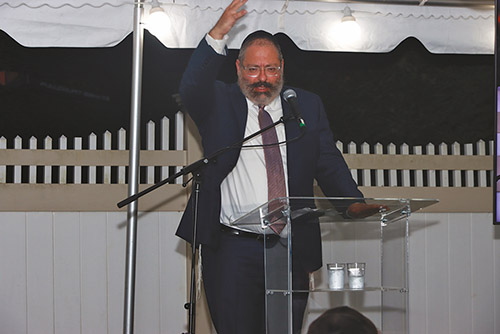



For many women in Israel suffering from financial and emotional stress, the news of a pregnancy is too much to bear. That’s where Just One Life (USA), or Nefesh Achat B’Yisrael (Israel), steps in. The organization held its annual Teaneck/Bergenfield benefit recently, hosted by once again by Rachel and Azi Mandel and Sheryl and Aaron Liberman.
Contrasting last year with no in-person attendance to this year’s outside venue, Mandel welcomed the audience, live and virtual, to an evening of inspiration by JOL and the inspirational messages of Rabbi Y.Y. Jacobson, noted Torah scholar, teacher and mentor.
Rabbi Martin Katz, executive vice president of JOL/NAB since its inception more than 30 years ago, thanked the hosts and the tireless committee for organizing the evening. He announced that the event marked the formal introduction of Rav Reuven Feinstein as the official posek for JOL/NAB after the recent passing of his illustrious brother Rav Dovid Feinstein, zt’l.
Rabbi Katz praised JOL chairperson Chaya Gitelman and her team of social workers and therapists headed by Chaya Katzin for their extraordinary care for over 650 clients during this past year when the COVID pandemic exacerbated the desperation of the women and families who turned to the organization for life-saving assistance. A brief video with testimonials by staff and clients lent a personal, passionate voice to the mission of the organization: to save one life at a time, Nefesh Achat B’yisrael.
Rabbi Jacobson followed up on the mission by relating the story of Rabbi Chaim Gutnick, a British native, who relocated to serve as a rav in Melbourne, Australia, in the 1960s. At a meeting with the Lubavitcher Rebbe before his departure, Gutnick was urged by the Rebbe to strengthen the adherence to taharat hamishpacha (family purity) in Melbourne by offering lectures and coordinating events to address the issue.
Gutnick was skeptical as he knew of the lack of interest and compliance with the laws of family purity in his own community. Sure enough, he planned a series of eight lectures on the topic, and only one woman was in attendance at all eight lectures.
On a subsequent visit to the Rebbe, Gutnick dreaded the inevitable query about the turnout to his lectures. When he reported that only one woman was in attendance, the Rebbe did not seem at all disappointed and immediately responded with the following question: “And how many mothers did Moshe Rabbeinu have? One mother, who single-handedly ensured his survival so that he could go on to become the greatest leader of the Jewish people. How can you be disappointed knowing that this one woman will pass the torch down to the generations to follow who will adhere to the halachos?”
Focusing on the need for hope and optimism when dealing with the misfortunes and plights of members of the community, as do the administration and health care workers of JOL/NAB, Rabbi Jacobson offered the following story recorded in Gemara Yuma 39:2. One Motzei YomKippur, Rav Shimon Ha’tzaddik, from the last of the Anshe Knesset Hagadol (the Men of the Great Assembly), exited the Kodesh Hakodashim with a sad demeanor and declared, “This year I shall die.” Immediately after Sukkot of that year, Shimon Ha’tzadik did indeed die.
Teaching this story to his rabbinical students in 1944 as the Holocaust was still raging, Rav Joseph B. Soloveitchik warned his students to heed this unusual story. Whereas in years past, Shimon Ha’tzadik had seen in the Holy of Holies a vision of a white-garbed angel representing purity, glory, hope and brightness, the last year before his death, he saw a black-clad angel displaying darkness, hopelessness, grief and weakness.
What he was witnessing was the encroaching Greek takeover of the Jewish land and the corruption of Jewish morals with Greek immorality. This was too much for Shimon Ha’tzaddik to bear, and so he died shortly after. The rav was urging this group of new rabbis to see the light, the brightness, the hope and the glory of the future despite the darkness that was currently enveloping the Jewish people. And if they could not serve with this optimism, then they should not serve at all.
Rabbi Jacobson pointed out that by reciting “L’Dovid Ori V’yishi” beginning in the month of Elul and through Shemini Atzeret, we, too, like Dovid Hamelech, are asking Hashem to bond with us, to create an intimacy with the divine, so that we can withstand the enemies surrounding us. We ask Hashem for a seat next to him in the House of God, from which we can perform acts of kindness such as ensuring the healthy births of over 19,000 babies to Jewish families in Eretz Yisrael.










